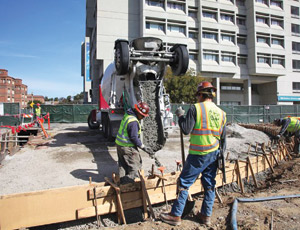As city and county officials and local trade unions work out the kinks in adhering to San Francisco's new local hire law, which went into effect on March 25, a state assemblyman from a county to the south is pushing new legislation that will shut down main elements of the ordinance.

The new San Francisco law, commissioned by Supervisor John Avalos, mandates that 20% of all project hours within each trade be performed by local residents on city projects in excess of $400,000. That percentage rises 5% every year until it reaches 50% in 2017.
In its first year, the law also requires that no less than 10% of all project work hours within each trade be performed by economically disadvantaged workers, eventually rising to 25%. According to opponents, the kicker is that the ordinance will be in effect for city-funded projects within 70 miles of San Francisco.
According to a city analysis, the ordinance will cost the city and contractors $9.3 million annually to oversee staffing requirements. In addition, violating the law could result in fines, amounts of which have not been disclosed.
Exempt Projects
Avalos says that two of the city's biggest regional projects are exempt from the ordinance: improvements to San Francisco International Airport, located in San Mateo County, and the Hetch Hetchy/SF Public Utilities Commission Water System Improvement Program, which includes projects stretching into the Central Valley and multiple counties.
San Mateo County Assemblyman Jerry Hill (D) introduced AB 356—currently in committee and slated for a vote later this year—that would prohibit the use of state dollars on local-hire projects throughout the state, including projects dubbed “local hire” by the city of San Francisco, and limits the ordinance to within the borders of the municipality only.
“The Bay Area is an economically interdependent region,” says Hill. “We need to focus on creating jobs regionally, not just in each city or county.”
Avalos contends the city/county's 10-year-old “City's First Source” program, which required contractors make good- faith efforts to hire 50% local residents on publicly funded projects, has not been working. He says that locals account for, on average, 20% to 25% of projects, according to a report by two local community activist non-profits, Brightline Defense and Chinese for Affirmative Action.
“Jerry Hill's legislation is ill-informed and misguided,” says Avalos. “If he truly read the city's local-hire ordinance he would see that it actually benefits San Mateo County workers. I don't believe his bill is going anywhere because it would be opposed by assembly members representing other parts of the state that have labor agreements with local-hire provisions.”
Meanwhile, local unions are not fully onboard with the new law.
Michael Theriault, secretary-treasurer of the San Francisco Building & Construction Trades Council, a coalition of 28 construction unions, says the report, which is the basis of the new law, sent to Avalos by the local community organizations is “shallow and shaped by preconceptions.”
Because of the limited numbers of available skilled union and journey-level workers, Theriault says, hitting the 50% local- hire mark, especially when the construction sector gets back to normal, would be extremely difficult.
Theriault says the city's former 50% local-hire provision was a “goal” and not a requirement, so finding hard data about contractors' efforts in this area might be hard to find. The maximum level of local hire that can theoretically be achieved through apprentice hire would be less than 17%, which means “to achieve the 50% goal, one-third of project hours, at minimum, must go to city residents who are journey-level workers,” he says.
Pumped-Up Bids
Facing penalties, contractors and subcontractors would boost their bids—maybe up to 15%—to cover the fines and extra costs, which means the city would pay more for projects, says Andy Ball, president of Web-cor Builders, San Mateo. In addition, Ball says that petitioning the mayor's Office of Economic Workforce Development for a waiver of the new law in cases in which qualified local hires cannot be found will be “challenging and time-consuming.”
The Engineering & Utility Contractors Association (EUCA), San Ramon, has made its members aware that certain community- based organizations (CBOs) have been approaching union contractors doing work in San Francisco and telling them that, in order to comply with the new 10% disadvantaged local-hire requirement, they need to recruit workers directly from the CBOs and not the unions.

Post a comment to this article
Report Abusive Comment